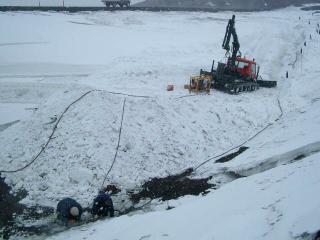| Antarctica - Nuggies On Ice |
| [ Home > Other Pages > Icy Problem ] |
| Antarctica presents a whole new set of conditions that can sometimes conspire to upset our communications network. What would probably be a small problem back in New Zealand takes on a new complexion in Antarctica. The following example, which occurred in December 2003, illustrates a less than typical problem, but nonetheless a problem that required a lot of radical thinking to bring our communication link back on line following an unexplained failure. |
| The Star Lake Problem ... |
| On 7th December, I noticed a sudden loss in level of the signal being received from our satellite station at Arrival Heights, (about 4.5 kilometres from Scott Base). Over the next week or so, this became steadily worse until we lost all communications with the outside world. All extra gain was called into play to restore the signal to a level barely above the noise floor. While all this was going on it became necessary to find out the cause. The prime suspect was a fault on the fibre-optic cable between Scott Base and the satellite station. |
| Test instruments showed that the likely site was located one kilometre back towards Scott Base from the satellite station. Unfortunately this was where a drift of snow up to 4-5 metres deep covered about 150 metres of the cable, (the result of a recent snowstorm). Locating the cable under this was going to be a problem. Preliminary attempts to follow the path of the cable through the drift showed that it was an impossible task with shovels. So a large snow-grooming machine called a Kassbohrer was used to shift the over-burden of snow and hopefully not rip the cable out of the ice in which it was embedded. An estimated 1500 cubic metres of snow was removed to get down to the embedding ice. Unfortunately the problem still existed somewhere in the thick ice holding the cable. This called for phase two of the operation. |
| We used a machine called a "hot-water drill" to cut through the ice. This machine heated water to around 90 degrees Celsius and then forced it under pressure through a nozzle. This method removed the ice very quickly indeed and the cable was freed quite fast. Murphy's Law of course meant that the problem was not discovered until the last bit of ice was removed. The picture, (above top), shows the Kassbohrer and the hot water drill machine near the bottom of the drift and the huge pile of snow removed from on top of the cable. The hot water drill is shown, (bottom picture above), being used to remove the ice, that was up to 600 millimetres thick, from the top of the cable. In the end the problem proved to be a small stone that was sitting on the cable and it had caused a bend in the fibres due to the huge weight of snow and ice positioned on top of it. The picture, (right top), shows the fibre cable, (the small one of the three), and the small stone, (in the centre of the picture). The scene the following day, after more snow had been cleared from further up the gully is also shown on the right, (bottom). This extra work had partly filled the huge clearance undertaken over the previous two days. This hopefully conveys some idea of the immensity of the task. The cable, for the moment, is safely resting on the ridge to the left of the picture. |



